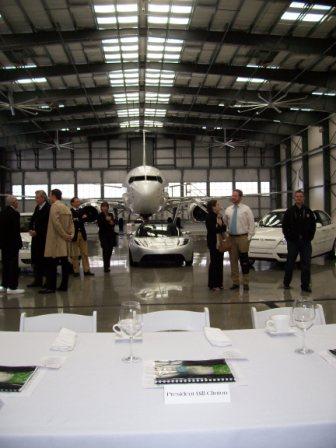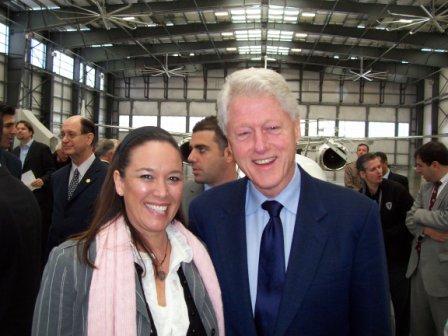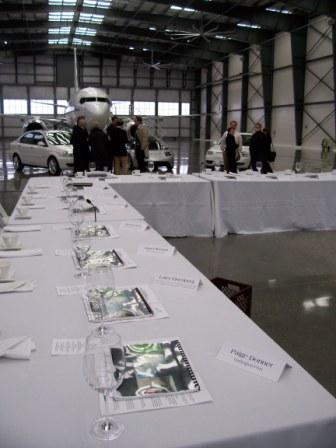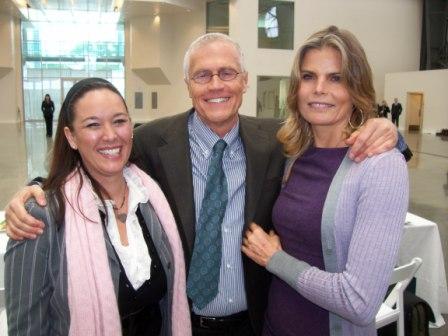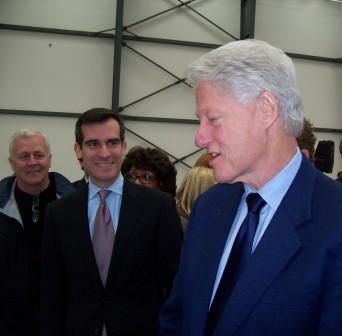
"I hate to be a Johnny-One-Note, but we aren't going to get there unless we dismantle this notion -- that it's less expensive to destroy the Earth than to maintain it -- that seems to be hardwired into people's psychologies throughout the world...including our leaders'. We need to be about economic development and social justice." President Clinton
Jet Hangar 25, Burbank, Calif., Built by Shangri-La Industries, Photo by Paige Donner
Paige Donner: Mr. President, how would you envision rolling out Jet Hangars such as these throughout the U.S. Air Force?
Clinton gazed around the jet hangar, noting that the private jet parked in the hangar was being powered via a solar-power sourced electrical outlet, and responded:
President Clinton: What if all commercial planes were maintained this way? What if the U.S. Air Force maintained their planes this way?
Notably, the U.S. Air Force is already purchasing synthetic jet fuel called RenJet. It is biodegradable, cleaner-burning fuel made from a wide variety of biomass including trash from municipal dumps, says producer Rentech, the L.A. based company who holds patent rights to the synthetic fuel technology. The Air Force has announced its goal to have 50% of its fuel supplied by domestic sources by 2016.
President Clinton and Paige Donner at Jet Hangar 25, President's Day, Photo by Mariel Hemingway
Green was definitely the color of the Clinton President's Day Round Table. Bill Clinton, also known as President Clinton, held a Round Table meeting in Burbank, California on President's Day. This was a meeting unlike any other.
First of all, it was held in Jet Hangar 25, the world's first Platinum LEED certified jet hangar, built by Shangri-La Industries, that is powered off of solar energy. Secondly, the man has more one-liners than you'd hear on a Comedy Central Larry The Cable Guy Roast. What other leader of the free world would ever say: "Sometimes I feel like an aged Rock Star. They roll you out every so often even though you're old and creaky," delivered with that irresistible Southern drawl?
But back to green...On President's Day, 2009, Clinton's interests focused on green energy and green technology and how these can be applied to stimulate the economy. In May 2007 the Clinton Climate Initiative rolled out its Energy Efficiency Building Retrofit program and Green Building initiatives. So it's an area he has personally focused on for some time.
President Clinton:
A lot of this [referring to Jet Hangar 25] is just thinking. One of the real problems that all societies have in all areas is that we organize ourselves to do things in a certain way, and that affects what we believe is possible. Because our reality boxes are geared to the way we're organized today instead of the way we could be organized tomorrow.
Joining President Clinton at the Round Table were: Paul Hawken, iconic environmentalist; Xavier Becerra, U.S. House of Representatives; Eric Garcetti, Los Angeles City Council President; Dave Golonski, Mayor or Burbank; Maxine Waters, U.S. House of Representatives; Laura Richardson, U.S. House of Representatives; Brad Sherman, U.S. House of Representatives; several more state and local officials and six of us members of the press. Invited guests included Antonio d'Ali, Senator and Environmental Chair, Italy; The Honorable Nancy Rubin, Former UN Ambassador, Human Rights; Rob Maguire, Chairman Maguire Aviation and many other distinguished members of the local, national and international community.
A significant feature of Shangri-La's Jet Hangar 25, which you can read more about here, is that it operates at 110% energy efficiency. Yes, it generates more power than it uses. That extra 10% it feeds back into the grid to provide power for its community. It does this with its rooftop solar panel installation. The jets, when parked in the hangar for ground maintenance, are powered by a plug that uses electricity juiced by these solar panels. It's the first of its kind and it is beautiful.
A couple of quick stats:
Buildings are the biggest emitters of greenhouse gases.
Buildings account for 40% of worldwide greenhouse gas emissions. [70% in cities like NY and London.]
In the U.S., buildings account for:
48% of energy consumption [Industry: 25%; Transportation 27%]
12% of water use
30% of greenhouse gas emissions
65% of waste output
Round Table Jet Hangar 25, Burbank, President's Day, Photo by Paige Donner
Excerpts from Conversations With A President, President's Day 2009
President Clinton's "Three Important Questions For Today":
1, What are we going to do?
2. How much are we going to spend on it?
3. How are we going to do it?
These people [Shangri-La Construction] are in the how business.
The single most important question is Can it [greening our world] be done in a way that's good for the economy instead of bad?
Current estimations of costs are horribly flawed. The U.N. reports say we will have to endure 1% reduction in GDP. Other countries won't get behind these green initiatives unless we can prove it is good business.
I've been foolin' with this for 30 years. This is not going to happen unless we burst that intellectual bubble [that mindset that says green is costly NOT cost-effective].
Greening our industries can have the same economic impact that mobilizing for WWII did in terms of mobilizing the economy and creating jobs.
We have to make it safe for the banks to provide lending for projects such as energy saving building retrofits.
My library is a Platinum LEED Building, the only Presidential library that is. Platinum LEED means everything used in terms of building supplies comes from 500 miles away or less. All of it is American-made.
[On the stimulus bill]
On a state by state basis we must see how we can use the money provided for existing building retrofits. Arkansas and California provide a model that is the most efficient through using their local utilities. Of all the things you put money into, it's the least sexy but the most important and it's infinitely expandable.
[More on Stimulus Bill]
For the first time Clean Energy was inserted as a jobs program creator in a stimulus bill. We should all be floating on air that this was done.
Paige Donner, Paul Hawken, Mariel Hemingway Jet Hangar 25, President's Day 2009, Photo by John Picard
Paul Hawken, heads the Natural Capital Institute, Biomimicry Ventures and Pax Group
Even the worse kind of damage is seen as additive to the GDP.
Is the aperture for change widening or has it contracted recently?
What can governments do to accelerate research and innovation?
- Paul Hawken
Xavier Becerra, U.S. House of Representatives - 31st District (in Congress since 1992)
We need to make Americans believers again that we can send a man to the moon.
What is needed is stability and predictability for the private sector to believe it can invest long-term in some of these projects.
Eric Garcetti, President, L.A. City Council
Business can lead the way. People don't have to choose an either or.
Our solar program is the largest for a municipally-owned utility.
People know the 'how.' What we can do as environmentalists is get away from just driving Priuses as being sexy and make sidewalks sexy again.
John Picard, Eric Garcetti, President Clinton Jet Hangar 25, Burbank, President's Day, Photo by Paige Donner
Bob Foster, Mayor of Long Beach, formerly Pres. of SoCal Edison
[On greening the port of Los Angeles.]
For this program we included the costs that real people pay - health costs, asthma - real costs that these people who work at the ports pay. We included these in the cost analysis - then it came out to Billions of dollars saved.
Richard Katz, Member, Board of Directors, Metropolitan Transportation Agency
Sits on the Board of Heal The Bay
We need to get green into the school curriculum.
Larry Eisenberg, Exec.Dir., Facilities and Planning, L.A. Community Colleges
It is key that we must change the intellectual construct about how we think about these issues.
We [LACC] are developing a program that will take us off the grid and require no capital cost outlay. We have established a feed-in tariff with the utilities that allows us to sell our excess energy into the grid. In the end, ultimately, we will have no energy bill. We will save $10M a year in energy costs. Through the use of solar, wind and geothermal energy technologies we produce all the energy we need. We serve 220,000 students per year. We are the largest community college district in the nation.
Clinton Seated At Round Table, Rep. Maxine Waters on Right, Rep. Laura Richardson on Left, President's Day 2009, Jet Hangar 25, Photo by Paige Donner
Maxine Waters, U.S. House of Representatives - 35th District
[On the stimulus bill.]
We need to make sure we help those involved in these issues to take advantage of these programs earmarked in the stimulus bill.
The loan guarantee thought that you, President Clinton, put on the table today is a good idea. Let's see how we can advance the notion of loan guarantees. I will take that to the Congress of the United States.
Laura Richardson, U.S. House of Representatives - 37th District
We hold the purse strings. If we're not going to have any skin in the game, we're not going to get anywhere.
[On the stimulus bill]
We have to say, we insist, that if we're going to give you the money it has to be spent the way we say it's to be spent. And then we have to go back and check. There is money there. The money needs to be spent in an energy-related way.
Mayor Dave Golonski, Burbank, California
The question is: When are we going to decide that we're going to do it?
We all know how we do it.
We need everyone working together. We need to all put the oars in the water and row together in the same direction: local government, state government and federal government.
Paul Hawken: I feel like I was in a moment where legislation was being made, right here, between the three of you. [Referring to Clinton, Waters and Becerra] And it's so exciting because I always heard it was like making sausage. But it didn't feel like making sausage at all. More like tofu. It has changed my whole picture of legislation being made. Extraordinary.
President Clinton [On electric cars:]
Here's the issue on electric cars:
The Chevy Volt is supposed to come online in 2010. The question for all this and whether we can be competitive is, can we get a battery small enough and light enough to enable it to push a car, whether it's these independent producers or established car companies, to push cars that can be priced competitively with the tax credits that Congress just gave us?The problem is the Chinese and others have been researching these batteries a long, long time so they could get the same acceleration and the same length of time on electricity for a battery that is smaller because most of the lithium in the world is still in the ground in South America. This is a big deal because the cost per unit of these batteries is still fairly substantial. So we need to keep trying to get smaller and smaller batteries that have the same impact that the bigger ones do today.
This is good. This is better. [He gestured to the two Miles All Electric Vehicles and one Tesla on display in the Jet Hangar that day.] Their cost is under $40K per unit. Not for Tesla in the middle. At my age I'd just be thrilled to go around the block in a car that looked like that. But anyway...
These are really important things.
Question from Alan Ohnsman, Bloomberg News: Tomorrow, our domestic auto makers, GM, Ford, Chrysler, will be reporting to Congress to tell them what progress they're making on turning their business around. You are talking about transitioning to a more sustainable energy future and you mentioned the Chevy Volt and you talked about batteries. These companies pretty much say they wish to do these things but they're in severe crisis right now. What's your counsel to these companies? Do you support continued federal assistance in exchange to come up with a more sustainable product?
President Clinton: Well, I would like to make just three observations. My short answer is: Yes, but.
And let me make full disclosure. When I was six years old I was under a car back when real human beings could still fix their own cars. You didn't have to be a robot or a genius to do it. My stepfather owned the little Buick dealership in our small town. I've been in the car business in one way or another all my life. I think that I could compete with any of you in knowing what is wrong with Detroit.
But I think we need to instill in the suppliers, the marketers, the leadership of America that we can produce things competitively. So, I would be in favor of helping them IF we do so in return for a sustainable plan that will enable them to produce the cars America needs and to operate in an economically viable way over the long run and that there's some monitoring system that's agreed to by the President and Congress.
Second thing I think you have to recognize is when Henry Ford first started mass-producing the Model A, there were probably 20 car companies in America. A lot. And I think, you could ask the people here from Tesla and Miles car companies agree with me, but I think it's quite possible that you will have, even if we achieve the victory or they rescue themselves with our help, I think it's quite possible that we will have eight or ten viable automobile companies in America in the next decade.
Because the variants to entry and the maintenance of position for electric cars are so much lower because there are so many fewer moving parts to this car. Get them to open the hood up for you.
Look at what the deal is and think about the engineering. You may be able to see small business people and entrepreneurs getting in this. It could be a very healthy thing for our economy. So the most important thing is we need to keep making these cars. But, yes, I would help them.
But only if the President and Congress were satisfied that this were a plan that is sustainable over the long run and will allow us to be competitive in a global market. I would actually do specific things.
You've all heard the old saw that General Motors is a healthcare company that produces cars on the side?
These things were organized for a time when A) we were not subject to international competition and B) thought employers could carry the whole load of an economy where the competitive pressures were entirely different than they now are.
Have they made mistakes? You bet they have. But also, the world changed. And in fact the political system kept ratifying the status quo. There was a bipartisan consensus to keep ratifying the status quo, of which, and I'm not pointing fingers, I was a part. We all have been. No one who's been in American politics in any reasonable position of responsibility in the past 30 years can claim they are blameless in the current dilemma faced by Detroit. I am not pointing the finger at anyone but myself when I say this. But we now know we've got to help them escape the whole mindset and way of doing business. So, yes, I would do it.
Question from Paige Donner, Huffington Post: Mr. President, it's an honor to be here today and especially among such distinguished guests. My aunt has a favorite saying, 'Coulda, shoulda, woulda...' so, moving forward, and also continuing in the vein of Eric Garcetti's earlier comment about private business being utilized to further a green agenda for the public good, looking forward, Mr. President, how would you envision rolling out Jet Hangars such as these throughout the U.S. Air Force?
[Clinton gazed around the hangar, noting that the jet parked in the hangar was being powered via a solar-power sourced electrical outlet]
President Clinton: What if all commercial planes were maintained this way? What if the U.S. Air Force maintained their planes this way?
Well, first of all, I have to tell you that the Defense Department recognizes that its energy footprint is very heavy. Second, we have a Secretary of Defense, as far as I know the first Secretary of Defense in my lifetime who has said that his soldiers have too much diplomacy to do and Congress should give more money to the Secretary of State for aid and development and the promotion of education and health and human rights.
This is very rare to have a Secretary of Defense say, please take some of my money and do this. So, therefore, they are going to be looking for ways to make the money they have go further because frankly the Army is too small, military families are strapped, and we have a lot of problems flowing out of our extended commitments in Iraq and Afghanistan. I spent a year going around America seeing very gripping evidence of human dimensions that our military families are facing.
So one good way for Secretary Gates to save a double ton of money is to use less energy. And so what I think we need to do, what I intend to do just being Bill Clinton the citizen, is to make sure that the Defense Department knows about this and try to get somebody who is in an appropriate position to come out and see all this interesting technology and how all of it or part of it could be adapted for the existing hangars we have in the military and the existing way we have of maintaining the planes and the whole nine yards. I'm just going to do that.
Paige Donner: You encountered some stumbling blocks in the context of establishing public-private partnerships when you first rolled out your Energy Efficiency Building Retrofit program in 2007 as part of the Clinton Climate Initiative. Can you speak to that?
President Clinton: You're right. One of the things that surprised me after we announced our building retrofit program is I felt that we were all dressed up with a model that couldn't fail and people still didn't want to take us out on a date. And they didn't realize that we could do this.
Now, I think, ironically, because of all the debates in Congress, even though the price of energy is a little bit lower than it was, I think there's more interest in this than there was before. And we all seem to be pushing in the same direction. So that's why I'm trying to recreate this sense of urgency here.
And in New York City, where we've done a lot of work, the only thing we've really done is replace our lights. We've still got to do all the construction stuff to make our buildings more efficient. So the bad news is we haven't done as much as we should have. The good news is if we spend this money right, and multiply its impact, we could get a lot more done than we otherwise could have.
It takes a long time to turn a ship around before it hits the iceberg. But we're doing it now.
Thank you all very much.
